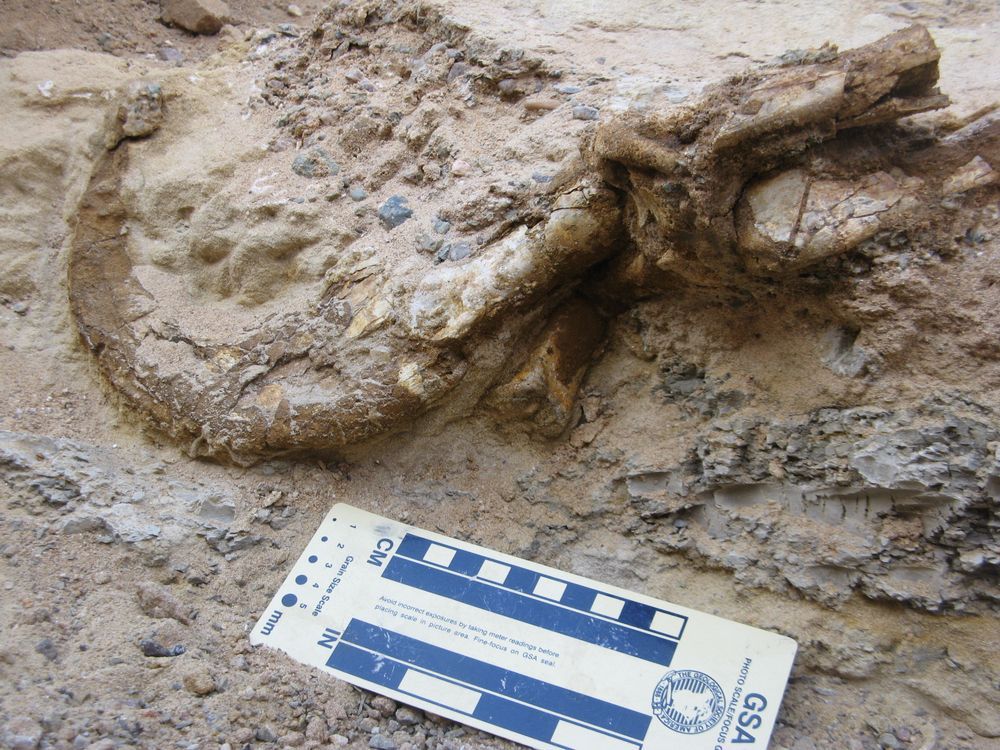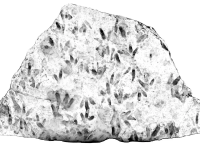New dinosaur species with foot-long claws discovered in Mongolia
The fossils included an 'exceptionally preserved' and strongly curved claw
Author of the article:Washington Post
Washington Post
Frances Vinall
Published Mar 26, 2025 • Last updated 19 hours ago • 2 minute read
The claw of Duonychus tsogtbaatari, a newly described species, was excavated in Mongolia on March 26, 2012.
The claw of Duonychus tsogtbaatari, a newly described species, was excavated in Mongolia on March 26, 2012. Photo by Yoshi Kobayashi /Hokkaido University
A new species of dinosaur uncovered in the Gobi Desert in Mongolia had two gigantic claws on each arm, according to findings published Tuesday in the journal iScience.
The fossils of Duonychus tsogtbaatari studied by scientists included an “exceptionally preserved” and strongly curved claw, one that probably made the species adept at grasping vegetation, the study authors wrote.
It could be “the largest fully preserved dinosaur claw” yet unearthed, study co-author Darla Zelenitsky, a paleontologist and associate professor at the University of Calgary, said in an email.
The claw included a sheath of keratin over the bone – the same material that makes up human hair and nails – which is much more vulnerable to disintegration over time.
“We know from this specimen that the claws were huge, around a foot long, and very sharp compared to the underlying bony core,” Zelenitsky said.
But she added that “despite such big, nasty claws, Duonychus was not a meat-eater.” They were in fact more like “the sloths or pandas of the Cretaceous [period]” in terms of their eating habits, and probably used their formidable talons to hook vegetation and pull it into their mouths.
The fossils were unearthed in 2012 during the construction of a water pipeline near a town in southern Mongolia. The findings, after researchers studied their significance, were published Tuesday.
The claw could have been so well-preserved because of what was happening at the time of the dinosaur’s death. “The conditions must have been just right so that the keratinous sheath was fossilized before it rotted away,” Zelenitsky said, adding that it was probably covered by the earth very soon after the creature died, protecting the claw from the elements and scavengers for about 90 million years.
Jake Kotevski, a vertebrate paleontologist with Monash University in Melbourne, Australia, who was not involved in the study, said in an email that many dinosaurs were presumed to have keratin covering their claws. But “very, very rarely” were fossils found with this part of the claw still intact.
“I think this is an exciting study that enhances our knowledge of theropod evolution,” he said, referring to a lineage of dinosaurs known for traveling on two legs, the most famous member of which is the Tyrannosaurus rex.
The new species, Duonychus tsogtbaatari, was two-fingered, which makes it unusual among its cousins in the Therizinosaur group, the study authors wrote. Therizinosaurs were long-necked herbivorous or omnivorous dinosaurs that lived in Asia and North America during the Cretaceous period.
“Therizinosaurs are classically some of the most bizarre dinosaurs out there,” said Phil Bell, associate professor of paleontology at the University of New England in Australia, who was not involved in the study. “New discoveries like this highlight just how strange they really were.”
He added that two-fingered dinosaurs were not unusual overall, but to see them “turn up in Therizinosaurs – a group famously known for their massive, scythe-like claws – is quite amazing.”
A partial skeleton of the species was also uncovered.
Duonychus tsogtbaatari probably weighed about 260 kilograms, or about 570 pounds, the study said.
It was named after Khishigjav Tsogtbaatar, a paleontologist and former director of the Institute of Paleontology at the Mongolian Academy of Sciences, which was also involved in the study.
![dinosaur_74tqxtbd46kpct7jlz5kwobvg4[1].jpg dinosaur_74tqxtbd46kpct7jlz5kwobvg4[1].jpg](https://forums.canadiancontent.net/data/attachments/26/26627-2a192a09c004b4262672e4cfaf7336dc.jpg)

 torontosun.com
torontosun.com
The fossils included an 'exceptionally preserved' and strongly curved claw
Author of the article:Washington Post
Washington Post
Frances Vinall
Published Mar 26, 2025 • Last updated 19 hours ago • 2 minute read
The claw of Duonychus tsogtbaatari, a newly described species, was excavated in Mongolia on March 26, 2012.
The claw of Duonychus tsogtbaatari, a newly described species, was excavated in Mongolia on March 26, 2012. Photo by Yoshi Kobayashi /Hokkaido University
A new species of dinosaur uncovered in the Gobi Desert in Mongolia had two gigantic claws on each arm, according to findings published Tuesday in the journal iScience.
The fossils of Duonychus tsogtbaatari studied by scientists included an “exceptionally preserved” and strongly curved claw, one that probably made the species adept at grasping vegetation, the study authors wrote.
It could be “the largest fully preserved dinosaur claw” yet unearthed, study co-author Darla Zelenitsky, a paleontologist and associate professor at the University of Calgary, said in an email.
The claw included a sheath of keratin over the bone – the same material that makes up human hair and nails – which is much more vulnerable to disintegration over time.
“We know from this specimen that the claws were huge, around a foot long, and very sharp compared to the underlying bony core,” Zelenitsky said.
But she added that “despite such big, nasty claws, Duonychus was not a meat-eater.” They were in fact more like “the sloths or pandas of the Cretaceous [period]” in terms of their eating habits, and probably used their formidable talons to hook vegetation and pull it into their mouths.
The fossils were unearthed in 2012 during the construction of a water pipeline near a town in southern Mongolia. The findings, after researchers studied their significance, were published Tuesday.
The claw could have been so well-preserved because of what was happening at the time of the dinosaur’s death. “The conditions must have been just right so that the keratinous sheath was fossilized before it rotted away,” Zelenitsky said, adding that it was probably covered by the earth very soon after the creature died, protecting the claw from the elements and scavengers for about 90 million years.
Jake Kotevski, a vertebrate paleontologist with Monash University in Melbourne, Australia, who was not involved in the study, said in an email that many dinosaurs were presumed to have keratin covering their claws. But “very, very rarely” were fossils found with this part of the claw still intact.
“I think this is an exciting study that enhances our knowledge of theropod evolution,” he said, referring to a lineage of dinosaurs known for traveling on two legs, the most famous member of which is the Tyrannosaurus rex.
The new species, Duonychus tsogtbaatari, was two-fingered, which makes it unusual among its cousins in the Therizinosaur group, the study authors wrote. Therizinosaurs were long-necked herbivorous or omnivorous dinosaurs that lived in Asia and North America during the Cretaceous period.
“Therizinosaurs are classically some of the most bizarre dinosaurs out there,” said Phil Bell, associate professor of paleontology at the University of New England in Australia, who was not involved in the study. “New discoveries like this highlight just how strange they really were.”
He added that two-fingered dinosaurs were not unusual overall, but to see them “turn up in Therizinosaurs – a group famously known for their massive, scythe-like claws – is quite amazing.”
A partial skeleton of the species was also uncovered.
Duonychus tsogtbaatari probably weighed about 260 kilograms, or about 570 pounds, the study said.
It was named after Khishigjav Tsogtbaatar, a paleontologist and former director of the Institute of Paleontology at the Mongolian Academy of Sciences, which was also involved in the study.
![dinosaur_74tqxtbd46kpct7jlz5kwobvg4[1].jpg dinosaur_74tqxtbd46kpct7jlz5kwobvg4[1].jpg](https://forums.canadiancontent.net/data/attachments/26/26627-2a192a09c004b4262672e4cfaf7336dc.jpg)

New dinosaur species with foot-long claws discovered in Mongolia
The fossils of Duonychus tsogtbaatari studied by scientists included an 'exceptionally preserved' and strongly curved claw

![australia-rock_htblibcg7ngxfktrwuk6u3nati[1].jpg australia-rock_htblibcg7ngxfktrwuk6u3nati[1].jpg](https://forums.canadiancontent.net/data/attachments/26/26661-b374dc97136726d221c16b000539bdc4.jpg)


![australia-rock_jkrkkxswjbfzhbuwo73jmbmdky[1].jpg](/data/attachments/26/26660-b11c580f6301cc372cdf56668dbcff34.jpg)





![Iceland-Volcano-2025-04-01[1].jpg Iceland-Volcano-2025-04-01[1].jpg](https://forums.canadiancontent.net/data/attachments/26/26779-60c5ae5c2b19f339c082c716e66baca9.jpg)




![Hawaii-Volcano-2025-04-08[1].jpg Hawaii-Volcano-2025-04-08[1].jpg](https://forums.canadiancontent.net/data/attachments/26/26901-b77c8c71b725e95e163c62d558321b10.jpg)







![Denisovan[1].jpg Denisovan[1].jpg](https://forums.canadiancontent.net/data/attachments/26/26952-2f01633c923c25e61fd5af0fde749155.jpg)





![ankylosaurs[1].jpg ankylosaurs[1].jpg](https://forums.canadiancontent.net/data/attachments/27/27074-234c564b896e316e789b21e454fc4b13.jpg)

